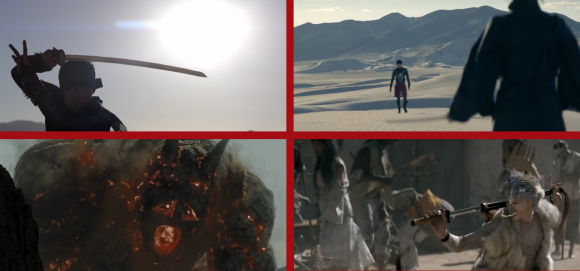
The story of Momotaro is one of Japan’s oldest folktales, but a lot of its elements seem a little silly. For starters, the hero’s name translates as “Peach Boy.” His companions are a monkey, a dog, and a pheasant, who he wins over by giving them some sweet dumplings in exchange for their help against the story’s villains, who all have outie bellybuttons.
Goofy as these details may sound, though, the core of the tale is absolutely epic. A young hero who harnesses the power of wild beasts, then sails into the heart of demon territory to rumble with them on their island fortress? In a world where every literary and comic character is a candidate to become a darkly stylish action hero (heck, even Batman’s gritty reboot is getting its own gritty reboot), why hasn’t someone revamped Peach Boy into something closer to Peach Man?
Actually, someone already has, but you won’t find the new Momotaro in theatres, and while you might catch him flipping through the channels on TV, you can’t find his adventures scheduled in the program guide. That’s because this amazingly awesome version of Momortaro is actually a series of commercials from Pepsi.
In Japan, Pepsi always has a novelty flavor, like pink strawberry, in its product planning pipeline. Not all of the company’s Japan-exclusives are so off the wall though, as the country is the only place where you can get the zero-calorie Pepsi Nex Zero.
We suppose Pepsi could have gone the traditional route for marketing low-calorie beverages, and shown a group of fashionably fit friends laughing together with a round of Pepsi Nex Zeroes after one of those oddly sweat-free workouts TV commercials are so fond of showing. Instead, though, we got this:
That’s Shun Oguri, who you might recognize from his starring role in the live-action Lupin III film, playing Momotaro. Along with the rousing fight song of British rock band The Heavy’s “Same Ol’,” the video is accompanied by the following text.
Long, long ago, a legion of oni (demons) invaded a village. They were far too powerful, and the villagers could do nothing to stand against them.
Hearing news of their plight, Momotaro enlisted the help of a dog, a monkey, and a pheasant, and set out for the Onigashima Island, the monsters’ home.
The band of heroes aren’t in for an easy fight, though, if the next episode’s flashback is anything to judge from.
This is a tale from the time before Momotaro met his animal companions, from when he challenged an oni alone.
The creature’s strength was beyond Momotaro’s imagination. Utterly defeated, he sought out a master swordsman.
The swordsman’s name was Miyamoto Musashi. Momotaro trained under him, and one day, became skilled enough to be a match for his master. On the day his training was complete, Musashi presented his disciple with a sword.
It’s not just the lead who gets a backstory dripping with pathos, though. The newest episode, which was just released this month, sheds light on the dog’s past, which makes Momotaro’s bitter backstory look warm and fuzzy by comparison.
Long ago, in the mountains where the wolves live, the animals found a human infant.
The wolves raised the boy as their own son, and lived together in happiness. However…
The oni appeared on the mountain, scattering the pack with their terrible strength. In an instant, all was lost. Only the boy was left alive, and his grief was so great that when morning came, his hair had turned white with sadness.
Wrapping himself in his only inheritance, the pelt of his dead mother, from that day forward, he would tell all he met that his name was Dog.
At 90 seconds, each episode is just long enough to whet your appetite for more of this incredible reimagining of the Japanese classic. Thankfully, since there’ve already been installments highlighting two of the four heroes, it’s safe to assume we’ll eventually see ones focusing on the remaining two, and at least one episode after they arrive on Onigashima. So we’ve got a minimum of three more episodes to look forward to, even if what we’d really like to see is these characters in a full length theatrical feature.
With all the awesomeness distracting us, though, we still haven’t addressed the question of what exactly any of this has to do with zero-calorie cola. Pepsi hasn’t come out and given an explicit explanation, but we’ve got a theory.
Because the goal of ads is to make you think you’ll be happier if you buy the product, most diet-related items are marketed by telling you how easy it is to lose weight. That’s a lie, as anyone who’s successfully shed several pounds or maintained an admirable physique can tell you. Staying in shape is hard, hard work, and the unspoken message in Pepsi’s commercials is that you’ll never get anything done running from that challenge. Meet it head on. Grapple with it. If it knocks you down, pick yourself up, wrap yourself in a wolfskin, and charge at it again.
Or, as the Japanese tagline that appears near the end of each episode says, “Defeat those stronger than you.”
Sorry, Nike. You had a good run with “Just do it,” but the world’s most badass creed now belongs to the Peach Boy.
Source: IT Media
Top image: YouTube (1, 2, 3)
Insert images: Pepsi, YouTube (1, 2, 3)

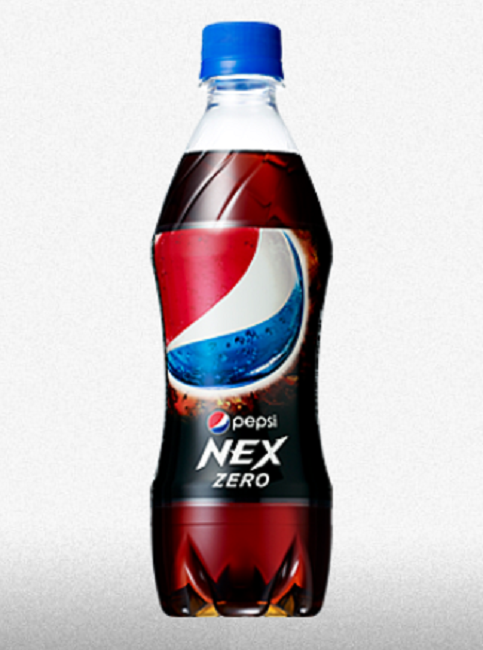

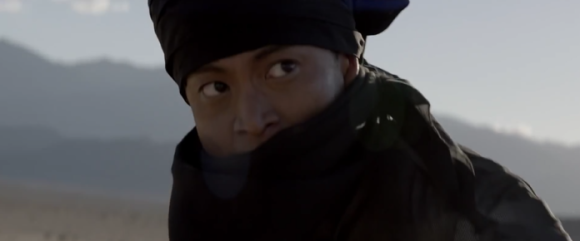
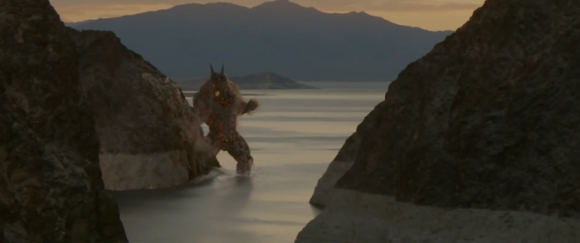
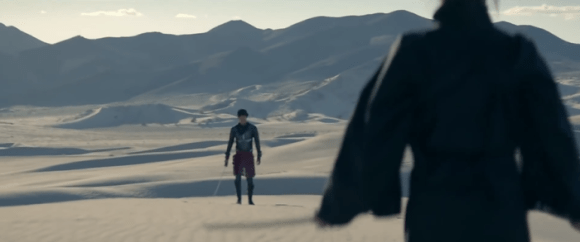
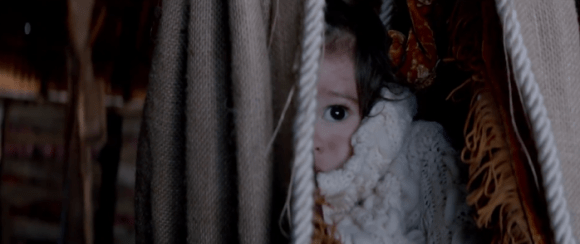

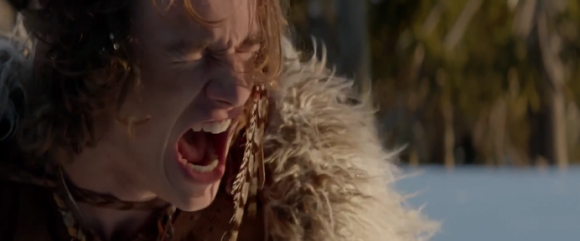
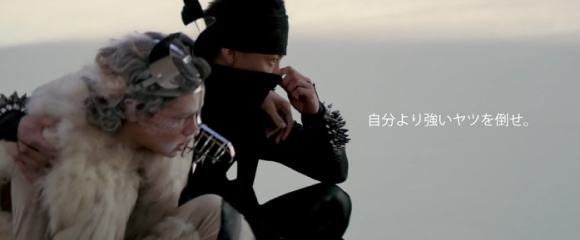
 Train etiquette poster features legendary Japanese folklore hero in an unusual plot twist
Train etiquette poster features legendary Japanese folklore hero in an unusual plot twist Peach Boy frozen snacks are strawberry flavored… with real apple juice
Peach Boy frozen snacks are strawberry flavored… with real apple juice Google made a free-to-play ninja cat RPG to celebrate the Tokyo Olympics, and it’s awesome!
Google made a free-to-play ninja cat RPG to celebrate the Tokyo Olympics, and it’s awesome! The Japan-exclusive Pepsi for fried chicken is here, but is it good?【Taste test】
The Japan-exclusive Pepsi for fried chicken is here, but is it good?【Taste test】 Vegetables are smarter than fruits: Three high IQ Japanese veggies
Vegetables are smarter than fruits: Three high IQ Japanese veggies Japan’s new difficult-to-drink-from beer glass protects your liver, but it’s a brutal experience
Japan’s new difficult-to-drink-from beer glass protects your liver, but it’s a brutal experience How to order snacks on a Shinkansen bullet train in Japan
How to order snacks on a Shinkansen bullet train in Japan New samurai glasses are Japan’s latest weird must-have souvenir
New samurai glasses are Japan’s latest weird must-have souvenir “Deflowering” services for virgin women are now a thing in Japan, apparently
“Deflowering” services for virgin women are now a thing in Japan, apparently Doraemon found buried at sea as scene from 1993 anime becomes real life【Photos】
Doraemon found buried at sea as scene from 1993 anime becomes real life【Photos】 Burger King Japan suddenly adds Dr. Pepper and Dr. Pepper floats to its menu nationwide
Burger King Japan suddenly adds Dr. Pepper and Dr. Pepper floats to its menu nationwide Hello, cosmetics! Clinique teams up with Hello Kitty this summer for first-time collaboration
Hello, cosmetics! Clinique teams up with Hello Kitty this summer for first-time collaboration Princesses, fruits, and blacksmiths: Study reveals the 30 most unusual family names in Japan
Princesses, fruits, and blacksmiths: Study reveals the 30 most unusual family names in Japan High-fashion Totoro cuddle purse is like an elegant stroll in the forest【Photos】
High-fashion Totoro cuddle purse is like an elegant stroll in the forest【Photos】 Demon Slayer: Kimetsu no Yaiba gets new roller coaster attractions and food at Universal Studios Japan
Demon Slayer: Kimetsu no Yaiba gets new roller coaster attractions and food at Universal Studios Japan Nintendo history you can feel – Super NES, N64, and GameCube controllers become capsule toys
Nintendo history you can feel – Super NES, N64, and GameCube controllers become capsule toys “The most Delicious Cup Noodle in history” – Japan’s French Cup Noodle wins our heart【Taste test】
“The most Delicious Cup Noodle in history” – Japan’s French Cup Noodle wins our heart【Taste test】 Starbucks releases a cute Frappuccino and Unicorn Cake…but not in Japan
Starbucks releases a cute Frappuccino and Unicorn Cake…but not in Japan Kyoto Tower mascot termination reveals dark side behind cute Japanese characters
Kyoto Tower mascot termination reveals dark side behind cute Japanese characters McDonald’s Japan’s Soft Twist Tower: A phantom ice cream only sold at select branches
McDonald’s Japan’s Soft Twist Tower: A phantom ice cream only sold at select branches Yabai Ramen: What makes this Japanese ramen so dangerous?
Yabai Ramen: What makes this Japanese ramen so dangerous? Finally! Nintendo Japan expands Switch 8-bit controller sales to everybody, Online member or not
Finally! Nintendo Japan expands Switch 8-bit controller sales to everybody, Online member or not Japanese government wants to build luxury resorts in all national parks for foreign tourists
Japanese government wants to build luxury resorts in all national parks for foreign tourists To combat declining birth rate, Japan to begin offering “Breeding Visas” to foreigners
To combat declining birth rate, Japan to begin offering “Breeding Visas” to foreigners 10 things you should buy at 7-Eleven in Japan
10 things you should buy at 7-Eleven in Japan Studio Ghibli releases anime heroine cosplay dresses that are super comfy to wear
Studio Ghibli releases anime heroine cosplay dresses that are super comfy to wear Woman charged for driving suitcase without a license in Osaka
Woman charged for driving suitcase without a license in Osaka Studio Ghibli unveils My Neighbour Totoro miniature house model
Studio Ghibli unveils My Neighbour Totoro miniature house model Kyoto experiencing problems with foreign tourists not paying for bus fares, but not on purpose
Kyoto experiencing problems with foreign tourists not paying for bus fares, but not on purpose Fighting mild hunger with a Japanese soda that turns into jelly in the stomach【Taste test】
Fighting mild hunger with a Japanese soda that turns into jelly in the stomach【Taste test】 Studio Ghibli’s Howl’s Moving Castle tapestry unveiled in Japan for first time
Studio Ghibli’s Howl’s Moving Castle tapestry unveiled in Japan for first time McDonald’s new Happy Meals offer up cute and practical Sanrio lifestyle goods
McDonald’s new Happy Meals offer up cute and practical Sanrio lifestyle goods Sales of Japan’s most convenient train ticket/shopping payment cards suspended indefinitely
Sales of Japan’s most convenient train ticket/shopping payment cards suspended indefinitely Sold-out Studio Ghibli desktop humidifiers are back so Totoro can help you through the dry season
Sold-out Studio Ghibli desktop humidifiers are back so Totoro can help you through the dry season Japanese government to make first change to romanization spelling rules since the 1950s
Japanese government to make first change to romanization spelling rules since the 1950s Foreigner’s request for help in Tokyo makes us sad for the state of society
Foreigner’s request for help in Tokyo makes us sad for the state of society Ghibli founders Toshio Suzuki and Hayao Miyazaki contribute to Japanese whisky Totoro label design
Ghibli founders Toshio Suzuki and Hayao Miyazaki contribute to Japanese whisky Totoro label design Tokyo’s most famous Starbucks is closed
Tokyo’s most famous Starbucks is closed Mint Pepsi for Yakisoba is coming to Japan, and we got to taste it before it goes on sale
Mint Pepsi for Yakisoba is coming to Japan, and we got to taste it before it goes on sale Pepsi’s new Japan Cola has a special ingredient: one of Japan’s most delicious sweets seasonings
Pepsi’s new Japan Cola has a special ingredient: one of Japan’s most delicious sweets seasonings Pepsi releases a new cola in Japan specifically for zangi
Pepsi releases a new cola in Japan specifically for zangi Pepsi releases a new cola in Japan specifically for karaage fried chicken
Pepsi releases a new cola in Japan specifically for karaage fried chicken Pepsi Japan to release its “most refreshing” cola ever
Pepsi Japan to release its “most refreshing” cola ever We tried Japan’s peach-flavored potato chips, and they do not disappoint in their peachiness
We tried Japan’s peach-flavored potato chips, and they do not disappoint in their peachiness Monkey pulls electrocuted buddy from train tracks, revives him as onlookers cheer【Video】
Monkey pulls electrocuted buddy from train tracks, revives him as onlookers cheer【Video】 Japan gets world’s strongest carbonated Pepsi, packaged in a new reinforced bottle
Japan gets world’s strongest carbonated Pepsi, packaged in a new reinforced bottle Pepsi creates a new cola for Christmas fried chicken in Japan
Pepsi creates a new cola for Christmas fried chicken in Japan Christmas cake-flavored Pepsi is set to make the holidays a little sweeter in Japan
Christmas cake-flavored Pepsi is set to make the holidays a little sweeter in Japan Ad featuring high school girls reconnecting with each other makes us feel warm and fuzzy【Video】
Ad featuring high school girls reconnecting with each other makes us feel warm and fuzzy【Video】 Thai commercial tugs at our heartstrings, reminds us to call our parents more often【Video】
Thai commercial tugs at our heartstrings, reminds us to call our parents more often【Video】 Suntory releases new Pepsi soft drinks only available in Japan
Suntory releases new Pepsi soft drinks only available in Japan “Pepsi Ghost” brings a mysterious new flavor for Halloween in Japan
“Pepsi Ghost” brings a mysterious new flavor for Halloween in Japan Family Mart’s Instagramable Galactica Grape and Fantasy Peach frappes warp into stores
Family Mart’s Instagramable Galactica Grape and Fantasy Peach frappes warp into stores
Leave a Reply